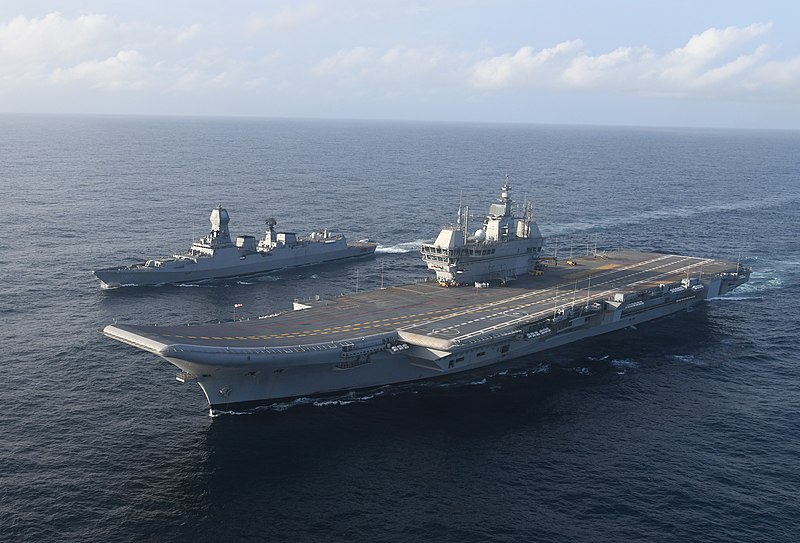Aerospace
7 Amazing facts to know about India’s first indigenous Aircraft Carrier
The brand-new navy aircraft carrier, INS Vikrant. Let’s explore some amazing details concerning the huge machine.

The brand-new navy aircraft carrier, INS Vikrant. Let’s explore some amazing details concerning the huge machine. Prime Minister Narendra Modi inaugurated the session where the Navy was given control of the massive aircraft carrier INS Vikrant, which joined the Indian Navy one day ago. Let’s learn more about this ship’s capabilities and why it is so crucial for protecting the Indian border.
It has 2,500 kilometers of cables
It generates enough electricity to run 5000 homes, and the wire will connect to Kashi from Kochi. there are 2,500 kilometers of cables. According to reports, IAC-1 contains 23,000 tonnes of steel, 150 kilometers of pipelines, 2,000 valves, and a variety of finished goods like rigid hull boats, galley equipment, air conditioning, refrigeration systems, and steering gear, indicating that more than 76% of the material and equipment on board is indigenous.
How many people worked in creating INS Vikrant?
According to reports, more than 50 companies directly employed almost 2,000 Indians each day on board IAC-1. Additionally, the project indirectly employed 40,000 people. Additionally, the approximately Rs 23,000 crore total project cost has been injected back into the Indian economy.
What is the INS Vikrant’s entire weight?
The new warship, which weighs 40,000 tonnes, is comparable to India’s present aircraft carrier, the INS Vikramaditya, which weighs 44,500 tonnes and can accommodate up to 34 aircraft, including fighter jets and helicopters. The battleship will be an unmatched military tool because of its ability to project Air Power over great distances.
What number of compartments did Vikrant have?
With 18 stories, INS Vikrant is referred to as a floating city. It has 14 decks and 2,300 compartments, which can hold about 1,500 sea warriors. The ship’s kitchen produces about 10,000 chapatis or rotis daily to meet the needs of the crew. The INS Vikrant has 2,400 compartments, 250 fuel tankers, and a 16-bed hospital.
What types of weapons can it hold?
With 32 Medium Range Surface-to-Air Missiles, Vikrant is armed (MRSAM). The Kavach anti-missile naval decoy system and AK 630 rotary cannons will also be installed on the aircraft carrier.
What types of aircraft will it transport?
The vessel has been built to fly “a variety of fixed wing and rotary aircraft,” according to the military ministry. In addition to the indigenously produced Advanced Light Helicopters (ALH) and the MH-60R multirole helicopter made by the American military firm Lockheed Martin, the MiG-29K fighter jet and Kamov-31 early warning helicopters developed in Russia will also be transported, according to the Navy. The largest ship ever constructed in Indian maritime history is the INS Vikrant. Its size is equivalent to two football fields.
What kind of INS is Vikrant using to power the enormous Fleet?
The new INS Vikrant, which is propelled by four 22 MW gas turbine engines, has a range of 7,500 nautical miles (about 13,900 km), which translates into an uninterrupted sea voyage from India to Brazil.

Aerospace
Boeing Transfers Rocket Stage to NASA, Paving Way for Human Moon Mission

Boeing has achieved a significant milestone by providing NASA with the second core stage of the Space Launch System (SLS) rocket.
This crucial component, crafted at NASA’s Michoud Assembly Facility (MAF), is set to propel the Artemis II crew into lunar orbit, marking humanity’s return to deep space after a 50-year hiatus.
The monumental Boeing-built rocket stage, the largest element of the Artemis II mission, will embark on a journey aboard the Pegasus barge, traveling 900 miles to NASA’s Kennedy Space Center.
Comparison of two legendary aircraft B777x vs B747 aircraft:Click here
Upon arrival, it will be meticulously integrated with other essential Artemis II components, including the upper stage, solid rocket boosters, and NASA’s Orion spacecraft within the iconic Vehicle Assembly Building. This intricate integration process is a vital step toward the eagerly anticipated Artemis II launch, slated for 2025.
“Boeing-built products helped land humankind on the moon in 1969, and we’re proud to continue that legacy through the Artemis generation,” remarked Dave Dutcher, vice president and program manager for Boeing’s SLS program. “Together, with NASA and our industry partners and suppliers, we are building the world’s most capable rocket and paving the way to deep space through America’s rocket factory in New Orleans.”
NASA, Lockheed Martin Reveal X-59 Quiet Supersonic Aircraft:Click here
The delivery of Core Stage 2 marks a significant achievement in the evolution of the SLS rocket. Towering over 200 feet and powered by four RS-25 engines, this core stage, coupled with two solid-fueled booster rockets, will generate a staggering 8.8 million pounds of thrust. This immense power is crucial to launching Artemis II and future missions into the vast expanse of space.
The SLS rocket stands unparalleled in its capability to transport both crew and substantial cargo to the moon and beyond in a single launch. Its extraordinary capacity will facilitate the delivery of human-rated spacecraft, habitats, and scientific missions to destinations including the moon and Mars, ushering in a new era of space exploration.
-

 Travel1 week ago
Travel1 week agoAir India to Expand US Operations with Three New Routes After a Decade
-

 Travel2 weeks ago
Travel2 weeks agoWhy We Should Avoid These Stamps in a Passport
-

 Airlines1 month ago
Airlines1 month agoInvestigations Reveal Fake Chinese Titanium in Boeing and Airbus Jets
-

 Tech4 weeks ago
Tech4 weeks agoChina’s CATL Plans 1,800-Mile Electric Plane Launch by 2027
-

 Airport3 days ago
Airport3 days agoTop 10 Largest Airports in the World by Size
-

 Aerospace4 weeks ago
Aerospace4 weeks agoChina’s Fighter Jets Turn Wings into Autonomous Drones
-

 Airlines4 days ago
Airlines4 days agoAir India Rolls Out A350s for Delhi-New York JFK and Newark Routes
-

 Defence3 weeks ago
Defence3 weeks agoBoeing Enhances Chinook with New Engines and Block II Upgrades at $96 Million







